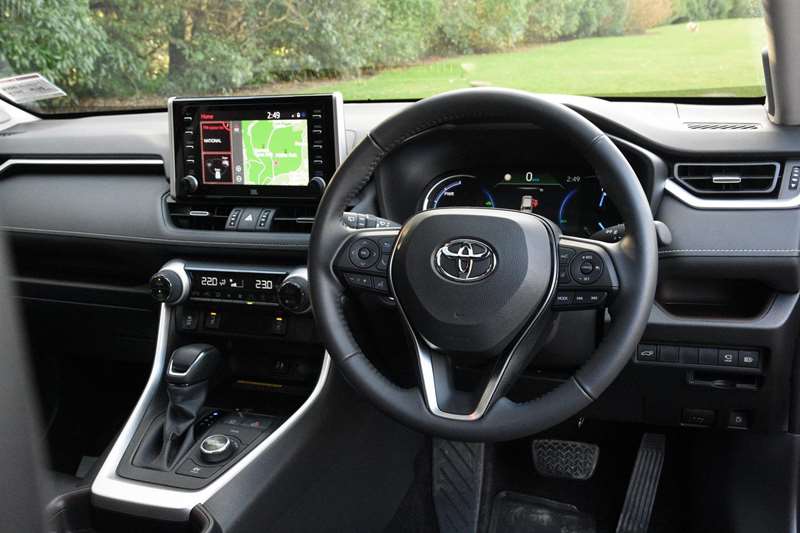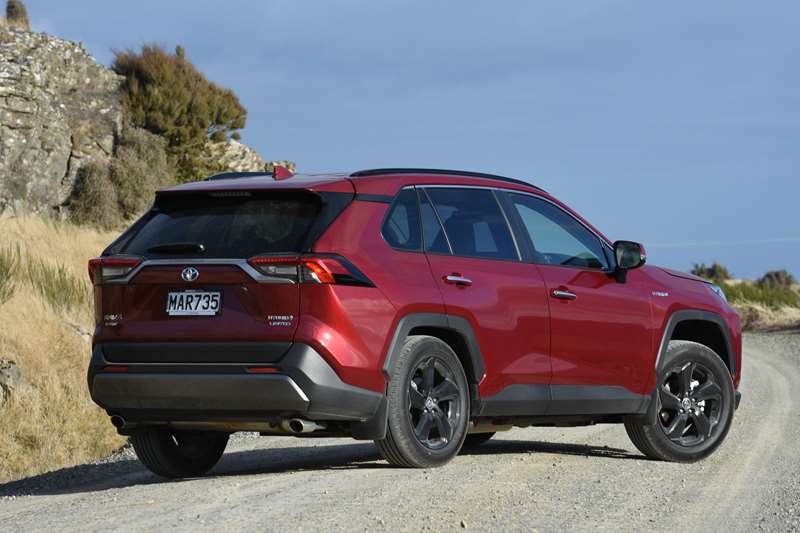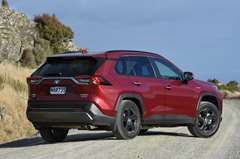Hybrid technology has found its way for the first time into the new iteration of the Toyota RAV4. David Thomson slips behind the wheel to discover what all the fuss is about.
What’s New?
Pause to think about it and the marvel is not that Toyota has abandoned a turbo-diesel option in favour of a petrol-electric hybrid version of the RAV4, but rather that it’s taken this long for a hybrid RAV4 to surface in this part of the world.
After all, the Japanese company has been offering the Corolla in hybrid guise for more than five years, and the Camry saloon and various models in the Lexus range (including the RX sports utility) for more than a decade. And while much has been made of this being the first hybrid RAV4, that’s only true insofar as New Zealand is concerned; the previous generation RAV4 also included hybrid variants, primarily for North America.
But here we are at last; the country’s top-selling SUV being weaned off hydrocarbons as it enters its fifth generation. With the Government’s recently announced plans to incentivise low-emissions vehicles, the timing couldn’t be better.
Taking its place in a range that includes petrol power at entry level (a 2.0-litre front-wheel drive) and in flagship guise (a 2.5-litre all-wheel drive), the hybrid option is offered at three specification levels, opening at $39,990 for the GX, and topping out with the $48,990 Limited, as tested.
In technical speak, the RAV4 hybrid is powered by a fourth-generation hybrid synergy drive system. This 163kW system, which pairs a 2.5-litre Atkinson cycle petrol engine with electric motors and a nickel-metal-hydride battery pack, has featured on several vehicles assessed by Drivesouth, most recently, the Lexus ES300h luxury saloon.
The system fitted to the RAV4 includes automated ‘‘E-Four’’ four-wheel drive, in which the front-wheels are powered by the main hybrid power system while a separate electric motor linkage delivers up to 80% of torque to the rear wheels when conditions demand it.
All new RAV4s are constructed around the latest Toyota New Global Architecture (TNGA).
This platform is used in slightly different forms by the latest Camry and Corolla and delivers increased rigidity and a lower centre of gravity. Significant changes have been made to the styling and interior packaging, too.
What comes as standard?
The new RAV4’s active safety suite embraces active radar cruise control, precollision autonomous braking (with pedestrian and cyclist detection), lane-tracing assistance, road sign recognition, auto-dipping headlights, blind-spot monitoring, rear cross-traffic alert, a reversing camera and front and rear parking sensors.
Within the hybrid range, the creature comfort and convenience list at GX level includes satellite navigation, an eight-inch centre-mounted touchscreen, and dual-zone climate control. Sitting on 18-inch rather than 17-inch alloys, the GLX adds keyless entry and pushbutton start, wireless phone charging and premium trims. The Hybrid Limited has artificial leather trim, heated front seats (the driver’s power operated), a power-operated tailgate, power sunroof, a 360-degree camera, and a premium nine-speaker JBL sound system.
What’s it like to look at?
Toyota’s styling has headed down an angular path in recent years, with the RAV4’s smaller SUV sibling — the CHR — one of the boldest exponents of this radical new look.
The shock factor is dialled back substantially with the RAV4, though it is still far sharper in appearance than the outgoing model. The dynamic cuts and creases are most evident at the front and rear, especially around the light clusters, but crop up elsewhere too, notably on the wheel-arches. Black alloys rims, black roof rails and subtle chrome garnishes give the Hybrid Limited its own particular sense of style, and there’s specific hybrid badging.
Interestingly, while elements of the new RAV4’s styling make it look larger than its predecessor, it is actually shorter, a bit lower, and slightly wider. There is, however, a 30mm increase in wheelbase.
What’s it like inside?
Helped by that longer wheelbase and extra width, the cabin of the new RAV4 is appreciably more spacious than that of its predecessor.
Accessed via a power-operated tailgate that is annoyingly slow to open, the boot musters a 500-litre capacity that expands to more than 1630 litres when the rear seats are folded forward. While not class-leading, this capacity is pretty good given that the hybrid — alone in the new RAV4 range — comes with a full-sized spare wheel and is also constrained by the battery back under the rear seats.
Those seats adjust for back angle, and gains in both shoulder and legroom are immediately apparent. Comparing the latest RAV4 with its predecessor, there’s more rear glass too, which improves visibility. Cupholders are incorporated in the flip-down centre armrest, the outboard rears seats have ISOFIX child seat anchors and there are separate rear air vents.
Up front, the seats are broad and comfortable, and deliver the command-style driving position that many folk seek in an SUV. Visibility is excellent in most directions, though thick rear pillars impair the rear three-quarter views. The provision of 360-degree camera and lane-keeping assist are useful compensations.
Toyota interiors have always been very well put together, but with this edition of the RAV4 the quality feel of trim materials takes a step up, with an abundance of soft-touch surfaces.
Storage options around the front of the cabin include a centre bin (also housing two USB charge points), and a handy tray above the glovebox on the passenger’s side. Twin cup holders sit between the centre bin and transmission shift, while the tray forward of the shift incorporates a wireless phone charger.
Toyota has dispensed with a CD/DVD player, and connectivity of both phone and remote audio devices is wireless. There’s no Apple Car Play or Android Auto smartphone mirroring yet, but it’s on the way. Along with the eight-inch centre display screen, there’s a seven-inch digital instrument cluster.
What’s it like to drive?
Various drive modes can be selected via a rotary control knob and adjacent buttons beside the transmission lever. These include an EV mode that allows the RAV4 to proceed for short distances at speeds of under 40kmh under electric power alone, as well as eco, normal and sport hybrid modes.
On test, I stuck mostly with eco hybrid mode in the interests of obtaining the best possible economy return. The final figure achieved was 6.4l/100km. While this figure was shy of the 4.8l/100km official standard cycle return for the RAV4 hybrid, it was still a decent result, and more representative of what will be achieved with a mix of hill, urban, highway and byway driving.
One way to send consumption rocketing will be to employ the RAV4 Hybrid’s towing capacity. At 1500kg braked, this capability is superior to that of a non-hybrid RAV4, and close to what key non-hybrid rivals from the likes of Mazda or Kia offer.
Another way to chew through the fuel would be to venture offroad for an extended spell. There’s a special trail mode on the RAV4 for just these situations, and this feature proved adequate on test for secure motoring over a short section of muddy and lightly rutted un-metalled road. That said, the RAV4 Hybrid isn’t really intended for anything beyond modest back-block adventuring.
For around-town work, the test car impressed as an easy, undemanding drive, exhibiting the low-speed refinement that is a characteristic of hybrid machines.
Motoring beyond city limits showcased the substantial improvements in refinement that have been made with this new iteration of the RAV4. Compared to previous non-hybrid RAV4s, this model rides better, has improved noise suppression, and feels more solidly engineered.
With these gains, and a hybrid drive system that musters plenty of power and torque when required, it is an accomplished highway cruiser.
Pointed in the direction of a few tarmac twists and turns, the test car showed fine cornering composure, albeit without the mechanical verve or steering feel of its most dynamically accomplished rivals.
The new RAV4 hybrid is an easy car to guide accurately through bends, and it remains well balanced as well as mild mannered unless severely provoked.
Verdict
With a hybrid system that provides decent performance as well as superior economy, a cabin that delivers ample space, and a chassis and suspension that combine improved refinement with greater driver involvement, the new RAV4 is a decisive step up from its predecessor. Toyota has every right to expect the hybrid RAV4, in particular, to show strongly in the private and fleet segments of the new-car market over the next few years.
Photos: David Thomson/netshowcar.com












